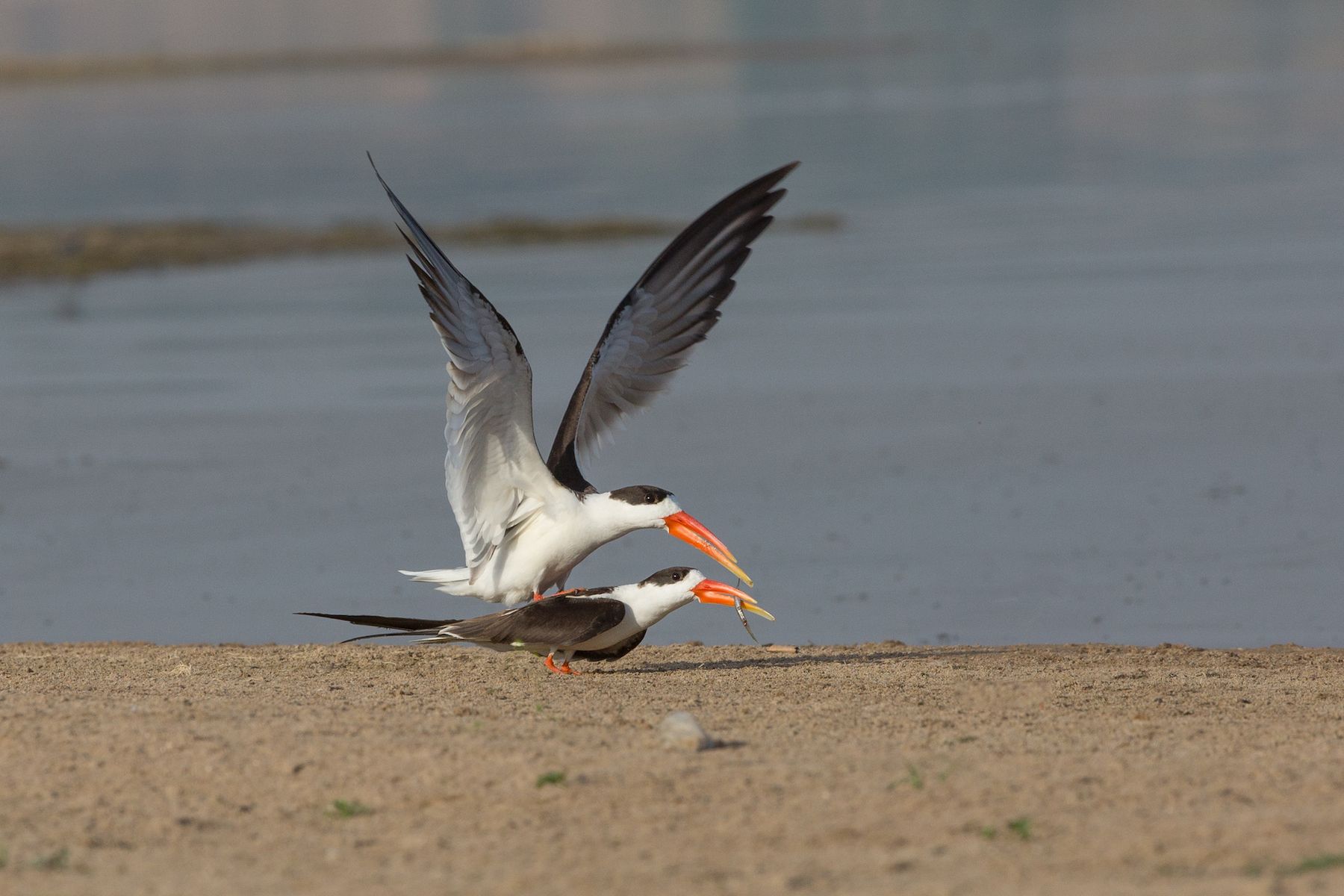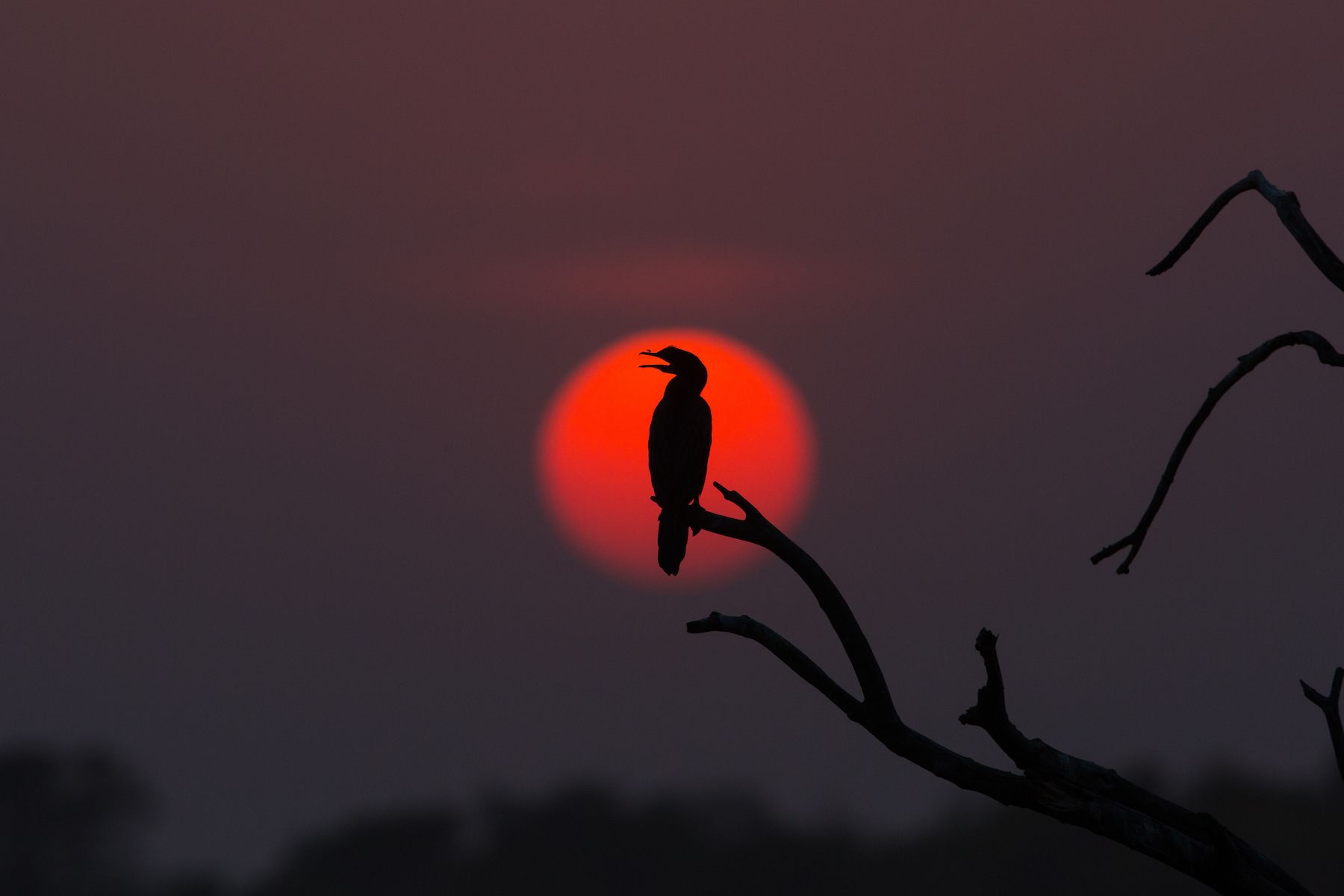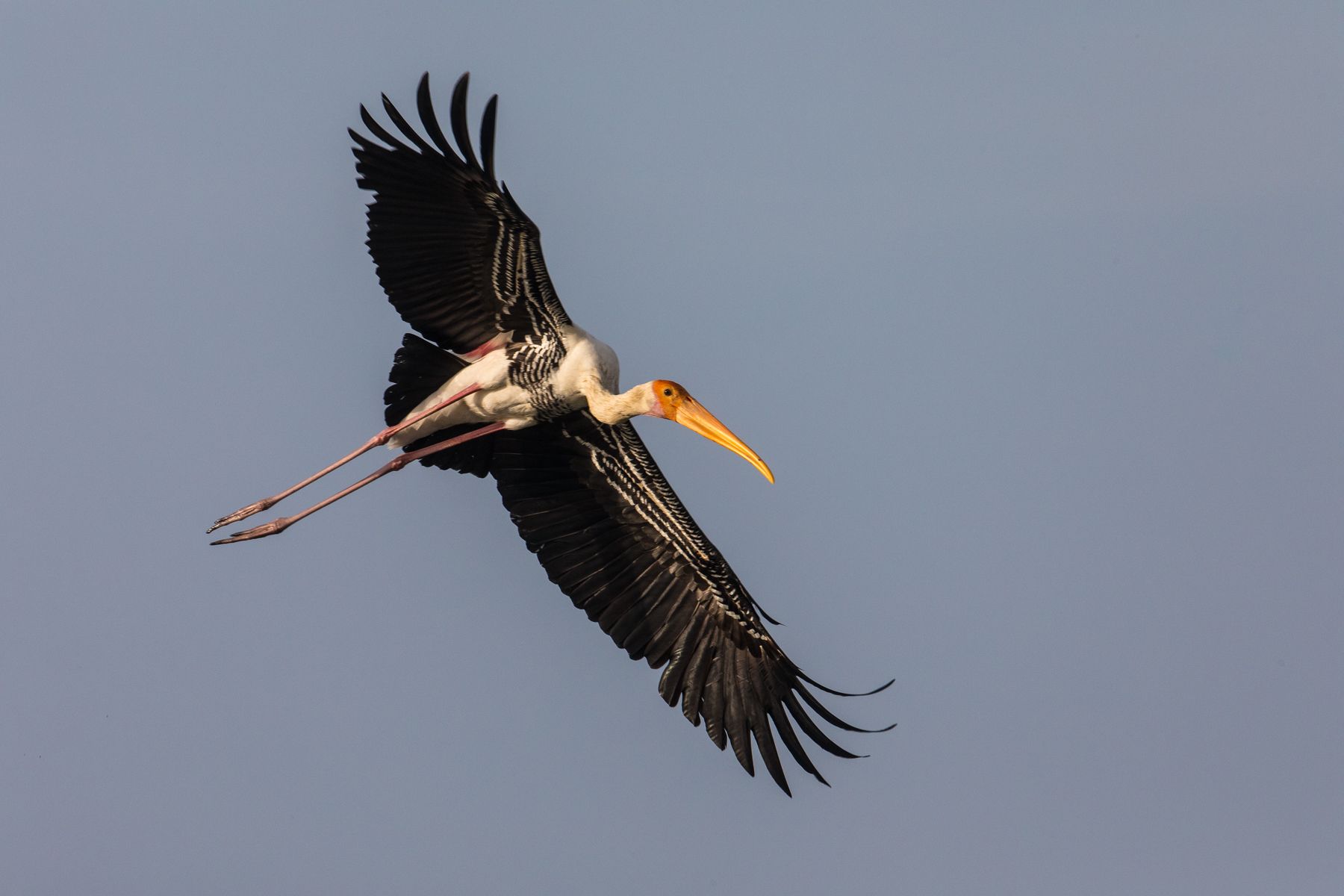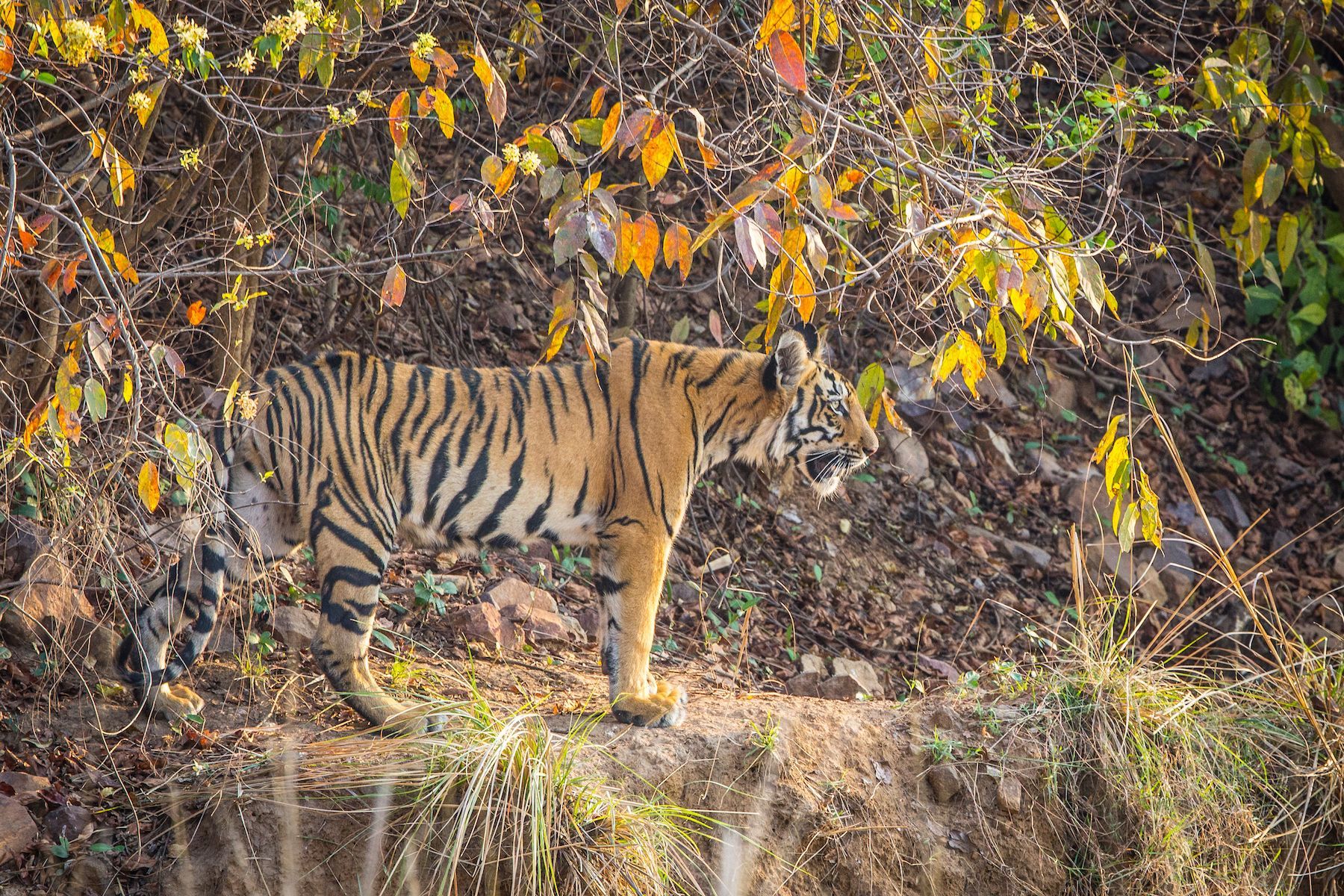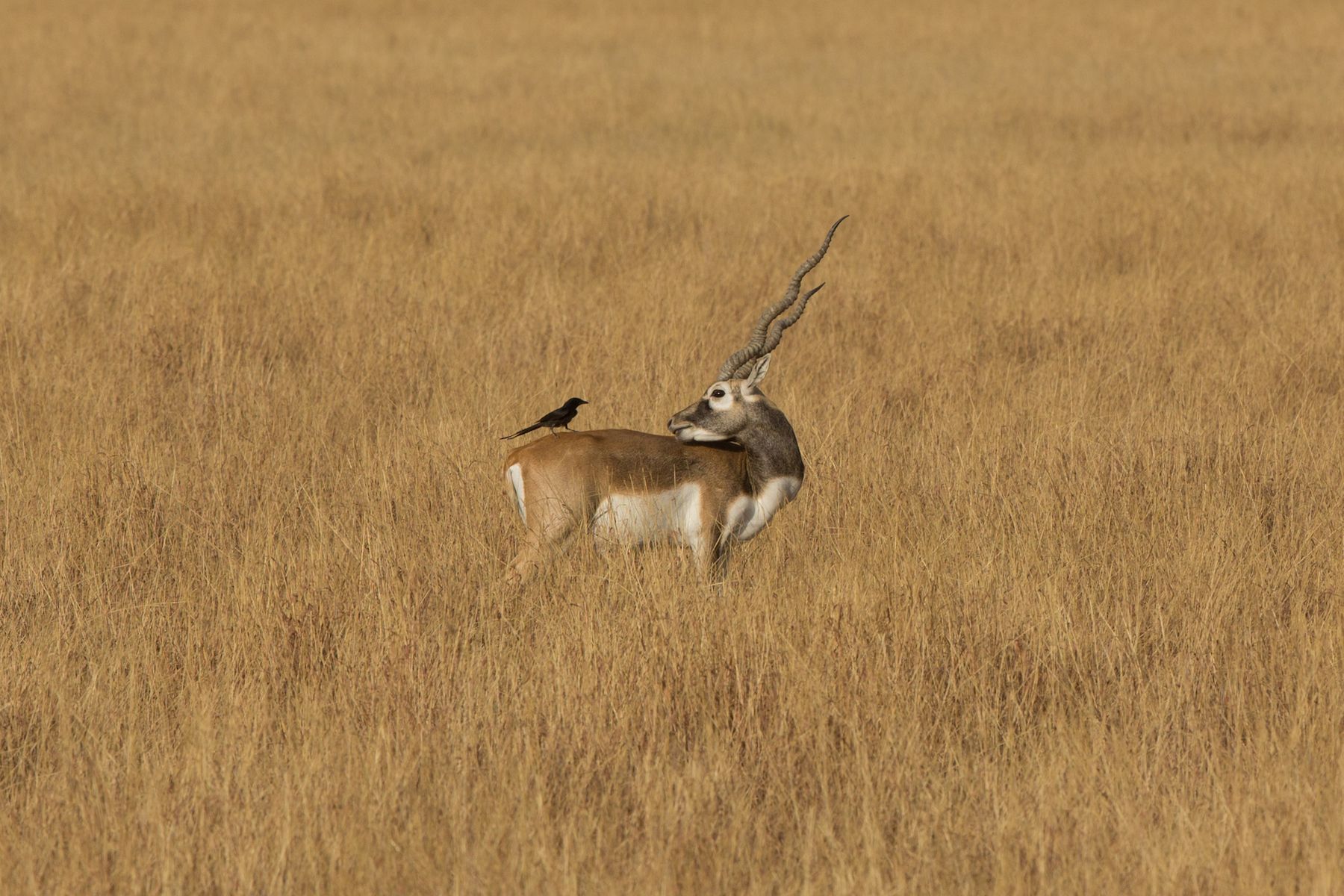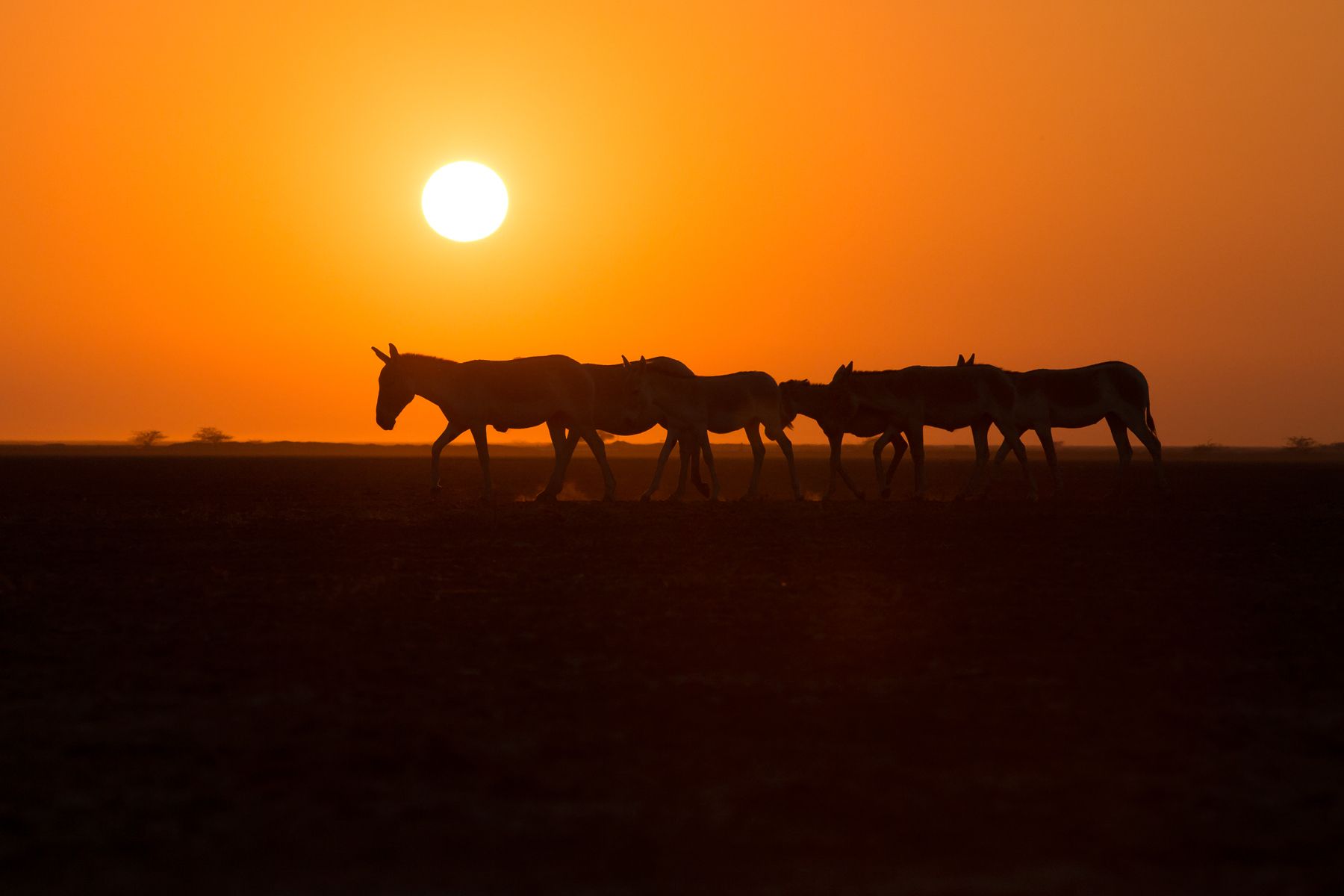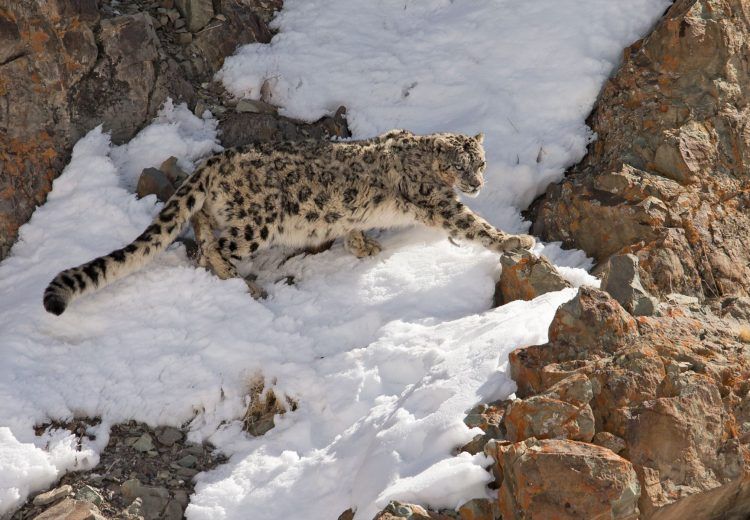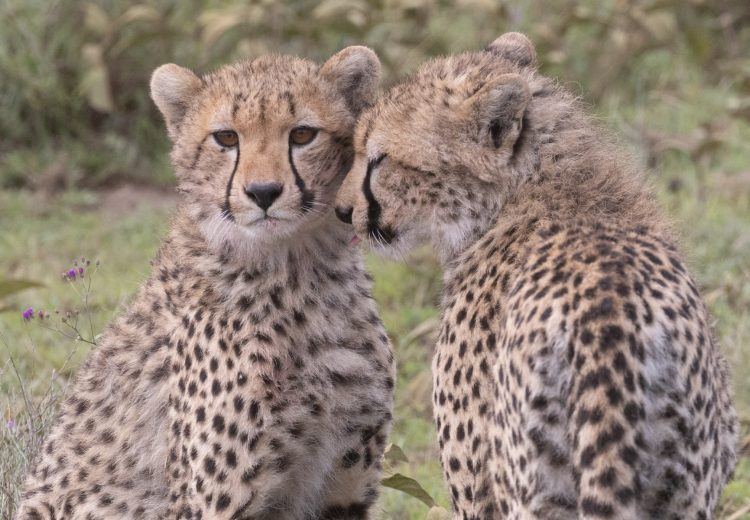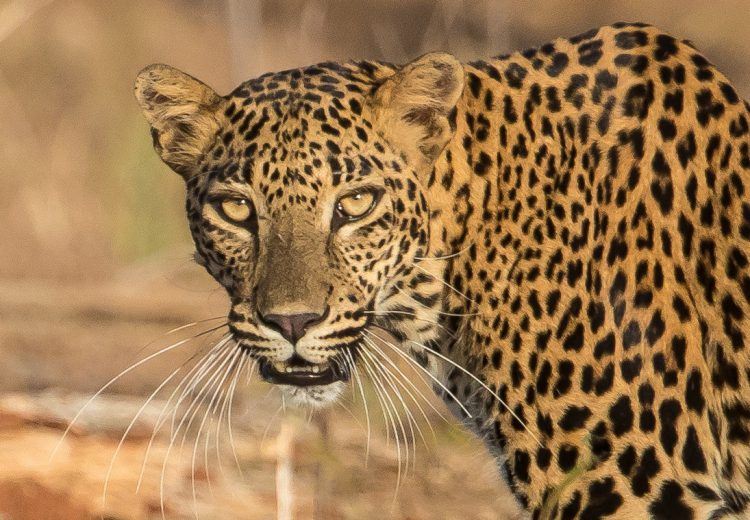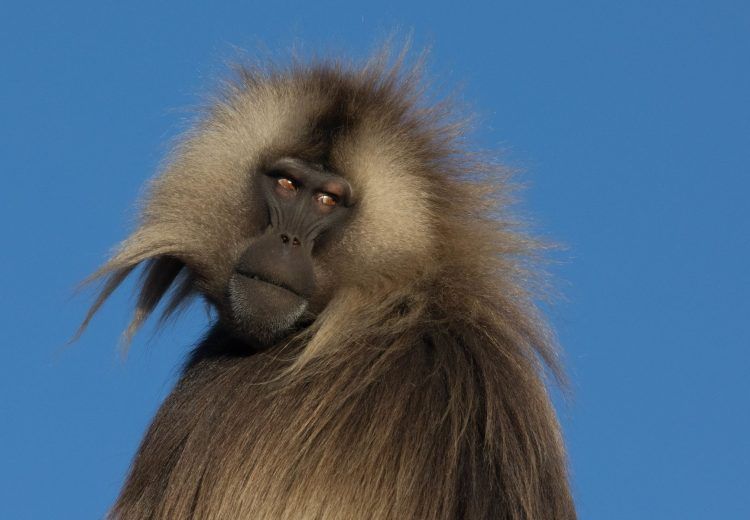India
INDIA: TIGER & WILDLIFE SPECTACULAR – Tadoba, Agra, the Chambal River, the Little Rann and Velavadar































































Mating Indian Skimmers on the Chambal River in Uttar Pradesh, India (Image by Inger Vandyke)

A Ruddy Shelduck in flight over the Chambal River in Uttar Pradesh, India (Image by Inger Vandyke)

Striped Hyena, Blackbuck National Park (Image by Mike Watson)

A Little Cormorant watches the sunset at Tadoba, India (Image by Inger Vandyke)

A Gharial swings around before it enters the water of the Chambal (Image by Mark Beaman)

Bathing Tiger cub at Tadoba Andhari (Image by Inger Vandyke)


A Leopard drinking (Image by Inger Vandyke)

Drinking Tiger in the late afternoon at Tadoba (Image by Inger Vandyke)

Portrait of Sonam in Tadoba (Image by Inger Vandyke)

Portrait of a wild Gaur in New Tadoba (Image by Inger Vandyke)

Painted Stork in flight in India (Image by Inger Vandyke)

Sloth Bear in Tadoba (Image by Inger Vandyke)

By March Short-eared Owls are nocturnal hunters at the Little Rann of Kutch (Image by Mike Watson)

A Tiger wanders down to a waterhole in Tadoba Andhari Tiger Reserve in India (Image by Inger Vandyke)

A Dhole or Indian Wild Dog runs across a track at Tadoba Andhari Tiger Reserve (Image by Inger Vandyke)

Sightings of Striped Hyena on every one of our jeep rides was the highlight of Blackbuck National Park (Image by Mike Watson)

Albino Blackbucks are mostly female animals (Image by Inger Vandyke)

A drongo sitting on the back of a Nilgai in Blackbuck National Park, Velavadar (Image by Inger Vandyke)

Gorgeous ‘Miss W’ takes a bath in Tadoba’s Junona Beat (Image by Mike Watson)

Maya and her boy cub at the famous Pandarpauni waterhole at Tadoba (Image by Mike Watson)

The elegant Blackbuck is truly the most beautiful antelope in India (Image by Inger Vandyke)

Black-Winged Stilt wading on the Chambal River in Rajasthan

When a Jungle Cat closes its eyes during a hunt, it isn't sleeping, it is simply shutting down its sight so it can listen for prey (Image by Inger Vandyke)

An extraordinary sunset in Gujarat, complete with parallel dark bars across the sun's disk (Image by Inger Vandyke)

Bathing Tiger cubs in Tadoba Andhari Tiger Reserve, Maharashtra, India (Image by Inger Vandyke)


Portrait of an Indian Thick-knee (Image by Inger Vandyke)

Swinging from the trees in Gir. A Grey Langur keeps us entertained at Gir (Image by Inger Vandyke)

A young Blackbuck peers at a Black Drongo that has landed on its back, Velavadar, Gujarat (Image by Inger Vandyke)

Indian Skimmer in flight (Image by Inger Vandyke)


A Bengal Fox kit takes a rest from playing, with some of the native vegetation still on its nose (Image by Inger Vandyke)

A line of Indian Wild Asses at sunset in the Little Rann of Kutch, Gujarat (Image by Mike Watson)

Mottled Wood Owl (Image by Inger Vandyke)

The mesmerising ripples of the Chambal River at sunset (Image by Inger Vandyke)

‘Slow down mummy’ said baby Sloth Bear (Image by Mike Watson)

A cheeky baby Grey Langur on the road in Tadoba (Image by Inger Vandyke)

Hanuman Langur at Tadoba Andhari Tiger Reserve in Maharashtra (Image by Inger Vandyke)

Painted Stork on the banks of the Chambal River in Uttar Pradesh, India

Black-winged Stilt wading through the shallows of the Chambal River (Image by Inger Vandyke)

A pair of Great Thick-knees roost on the banks of the Chambal River (Image by Inger Vandyke)

Gharial on the shores of the Chambal River (Image by Inger Vandyke)

It's Baloo! A Sloth Bear in Tadoba Andhari Tiger Reserve, Maharashtra, India (Image by Inger Vandyke)

A very rare sighting of a nesting Sykes's Nightjar, the first record of this bird nesting in the Little Rann of Kutch, Gujarat, India (Image by Inger Vandyke)

This Striped Hyaena allowed us a very close approach (Image by Inger Vandyke)

A Sloth Bear approaches Jonam Jhora waterhole for a drink (Image by Inger Vandyke)

A pretty little Spotted Owlet (Image by Inger Vandyke)

Mugger Crocodile on the banks of the Chambal River (Image by Inger Vandyke)

Indian Wild Asses at sunset in the Little Rann of Kutch (Image by Inger Vandyke)

Leopard at Tadoba - we’ll take partly obscured (Image by Mike Watson)

Tadoba Tigers (Image by Inger Vandyke)

Twins? A pair of Grey Langurs in Tadoba (Image by Inger Vandyke)

River Lapwing on a sand bank (Image by Inger Vandyke)

An Asian Openbill carrying nesting material at Tadoba (Image by Inger Vandyke)

Rutting Spotted Deer or Chital in Tadoba (Image by Inger Vandyke)


A flying Indian Skimmer backlit by the sunset on the Chambal River in Uttar Pradesh, India (Image by Inger Vandyke)

A Sloth Bear cools off in a waterhole at Tadoba Andhari, India. This is a sought-after species for wildlife photographers (Image by Inger Vandyke)

The majestic Nilgai (or Blue Bull) is an antelope that looks like it has been made from spare parts of other animals (Image by Mike Watson)

Little Pratincoles roosting on an island in the Chambal River in India (Image by Inger Vandyke)
|
Wednesday 19th March –
Sunday 6th April 2025 Leaders: Bernd Rohrschneider and local naturalist guides |
19 Days | Group Size Limit 6 (2 spaces) |
|
Thursday 19th March –
Monday 6th April 2026 Leaders: Virginia Wilde and local naturalist guides |
19 Days | Group Size Limit 6 |
INDIA TIGER & WILDLIFE PHOTOGRAPHY TOURS WITH WILD IMAGES
Tiger! Surely one of the most evocative creatures that still shares our crowded planet with us, but for how much longer? Of all the mammals that wildlife photographers dream of photographing, the magnificent Tiger surely tops the bill! But Tiger photography is not an easy thing to do. Unlike, for example, Lions in Africa, Tigers in India and other parts of Asia are rare and far more secretive, at least in many wildlife sanctuaries. Those making short visits to the wildlife reserves of India are sometimes lucky enough to see a Tiger or two on their travels, but often views are brief and quite often there are no sightings at all. To see and photograph Tigers well it is necessary to spend plenty of time and also to visit the very best and most reliable Tiger reserves in India. Furthermore, the very best period for frequency of Tiger sightings is during the dry but hot season from late March to May, with the period November to February, when many overseas wildlife photographers come to India because of the cooler weather, being much less good.
In order to make those Tiger photography dreams come true, we will be exploring what is probably the best wildlife sanctuary in India for Tiger sightings at the present time, the little-known but brilliant Tadoba Andhari Tiger Reserve in Maharashtra in Central India. This huge and remote park, situated in the hill ranges of central India that were immortalized by Rudyard Kipling in the Jungle Book, protects vast tracts of largely deciduous forest which still hold many Tigers. Tadoba is currently recognized by discerning wildlife photographers as one of the very best places to go if one wants great photography encounters with Tigers.
In this wonderful reserve in Central India you can expect, not just hope, to get multiple sightings of these extraordinary and beautiful predators, often at close range, and sometimes one can watch them for long periods at a time! Staring into the huge, cold yellow eyes of a Tiger just a short distance away is an awesome experience, and Tadoba is where it can happen. We will explore the park by jeep and some of the Tigers are now so used to the presence of people that they seem unconcerned by their close proximity. From the well-sited lodge we use at Tadoba, with its expert guides, our group members have a good chance of sighting over 10 Tigers during a 10 days stay, and we could even record as many as 20-30 or even more! (By this we do not mean the number of different Tiger individuals, but the cumulative total of Tigers sighted.) Needless to say, Tadoba has recently become something of a Tiger photography Mecca, but it remains far less well known than places like Ranthambhore, Bandhavgarh and Kanha, even though, in our opinion, it is even better.
Tadoba holds a great variety of other wildlife and among large mammals offering good photography potential are the huge Gaur (or Indian Bison), the beautiful Chital (or Spotted Deer), Sambar (a large Red Deer/Elk-sized species), Nilgai (or Blue Bull, one of the world’s largest antelopes), Wild Boar and the characterful Hanuman (or Grey) Langur.
We have a very good chance of multiple encounters with Sloth Bear and a good chance of coming across the rare and declining Dhole (or Asiatic or Indian Wild Dog). The sanctuary also produces sightings of Leopard, Jungle Cat, Golden Jackal and sometimes the rare Chowsingha (or Four-horned Antelope).
Tadoba holds a rich selection of birdlife and among the species that often provide superb wildlife photography portraits are Indian Peafowl (the males will be in full display at the time of our visit), Lesser Adjutant (a huge stork), Crested Serpent Eagle, Crested Hawk-Eagle, Mottled Wood Owl, Indian Scops Owl, Jungle Owlet and Savannah Nightjar.
The Tadoba Andhari Tiger Reserve is of course the major focus of this Indian wildlife photography journey, but our rich tapestry of experiences will be further enhanced by spending some time in other parts of this huge country.
During the first part of our India wildlife photography tour, we will pay a visit to the city of Agra to see and photograph the ethereal Taj Mahal, a building that represents a pinnacle of human achievement and one which epitomizes the romantic India of a bygone era that pinnacle of human achievement. The riches accumulated by the Moghul emperors were used to build awe-inspiring strongholds and some of the most fabulous palaces and monuments ever constructed. Their lives and times seem like a fairy tale to us inhabitants of a much more crowded and less simple era, but they live on in the remarkable monuments they built that now emblazon India’s rich architectural heritage.
Afterwards we will explore the wonderful National Chambal Sanctuary, a little-known reserve on the Chambal River, one of the last clean waterways in Northern India, where we will have superb opportunities for photography with two species of crocodile (the long-snouted Gharial and the thick-set Mugger), Gangetic River Dolphins, bizarre Indian Skimmers, Bar-headed Geese, Great Stone Curlews, Small Pratincoles and River and Black-bellied Terns.
The final stage of our Indian wildlife photography journey, after our visit to Tadoba, will take in two national parks in the state of Gujarat in western India.
The Little Rann of Kutch is home to most of the remaining Indian Wild Asses (or Onagers), Lesser Flamingos and many other interesting creatures, including Bengal Foxes and sometimes Striped Hyaena (we will be hoping to visit dens of both to photograph the young ones). Our lodge has a den of Indian Crested Porcupine and we will hope to photograph this unusual nocturnal creature!
To the southeast lies Blackbuck (or Velavadar) National Park, where we will enjoy close-up encounters with the beautiful Blackbuck, surely one of the most striking antelopes of all. This is probably the best park in India for Grey Wolf encounters and is a great place for Jungle Cat and even Striped Hyaena.
Why we no longer include Gir Forest and its Lions
For some time we included a visit to Gir National Park in the Gujarat section of this tour, but we no longer do so. The ‘Asiatic’ Lions of Gir are quite famous, so this might seem a strange decision, but we have very good reasons for making it.
In the first place, the ‘safari’ system at Gir has become almost intolerable for serious photographers. As with virtually every other national park and wildlife sanctuary in India, Gir used to have two ‘safari’ periods daily, one in the morning and one in the afternoon. Then, in late 2015, the Gir authorities became unique in forcing in a third safari slot, apparently with only money-making in mind, which meant that everyone taking the early morning safari had to be out of the park by 09.00.
At first glance that would not seem too bad, as obviously the best light is early on, but Gir’s problem is that the route system is not only compulsory and one-way (with no turning around allowed), but all the best routes are extraordinarily long, being over 40 kilometres of dirt track in most cases. Just to get around this length of dirt track takes a long time, and all of it eats into what is now a meagre ration of time for photography. When one could go slowly, take time for photography and be out of the park by an 11.00 deadline it worked, but now it is often a helter-skelter, road-rally-like situation to get to the gate by 09.00. In our view, a deeply flawed experience, if not a horrendous one.
On top of all this, there is the serious corruption issue at Gir. We hate to say this, but the forest staff, or at least some of them, at Gir have long been ‘milking’ wildlife photographers by offering to drive the Lions out of cover towards photographers’ vehicles in return for substantial sums. We have even witnessed forest staff driving the Lions away from the tracks early in the morning so they could then make money by driving them back again! (Clearly, you can’t risk doing this with a Tiger, thank goodness, but the Gir Lions are so docile and used to humans in their world that they put up with it.)
It is with some regret that we have decided to exclude the now deeply-flawed Gir Lions experience from our tours, but Africa is the place to experience Lions in a far superior way. The ‘Asiatic’ Lions of Gir are no longer considered a distinctive form by most mammalian taxonomists: recent research implies that they are not distinct from Lions from Western, Central and Northern Africa. Indeed, there is now (as yet unsubstantiated) talk that the Gir Lions were brought there from Africa by one of the local rulers in times past rather than representing a relict population of genuine ‘Asiatic’ Lions. Who knows if that will turn out to be true?
Accommodation & Road Transport
The hotels/lodges used in Delhi, at the Chambal River, at Tadoba and at Nagpur are comfortable and of good quality. Blackbuck Lodge at Velavadar where we spend three nights is considered luxurious and is the only realistic option there. The basic lodge at the Little Rann of Kutch, where we spend two nights, is rustic but all rooms have private bathrooms. Road transfers are by cars or small coach. We use open-topped jeeps (with up to a maximum of 3 participants in each) inside the reserves at Tadoba (we use an open-sided safari truck at the Little Rann of Kutch). Roads in India are variable in standard but improving rapidly.
Walking
The walking effort during our India photography tour is easy throughout. There is little walking involved in most locations.
Climate:
Typically it will be warm to very hot, dry and sunny in the parts of India being visited. Although overcast weather is not infrequent, rain is uncommon at this season.
Photographic Equipment
If you are using a DSLR for wildlife photography you will need prime telephotos, with or without converters, that cover the range 200-600mm or more.(If your budget does not run to prime lenses, a high quality 100-500mm or similar zoom can be a great alternative.) Alternatively, you can get wonderful photography results with a high quality digital bridge camera with an 18-20x or higher optical zoom. If you have questions about what equipment you ought to bring, please contact us.
Our lodge at Tadoba offers the opportunity to use camera traps (trail cams) to be placed outside the fenced area around the lodge itself. Potential visitors include Sloth Bear, Leopard, Jungle Cat and even Tiger on occasion.
Photographic Highlights
- The chance to photograph majestic Tigers in the wild, multiple times
- Searching for Sloth Bears and Asiatic Wild Dogs at Tadoba
- Muggers, Gharials, Gangetic Dolphins and huge Softshell Turtles in the Chambal River, the last unpolluted large river in northern India
- Explore the vast salt flats of the Little Rann looking for Asiatic Wild Asses, Desert Red and Bengal Foxes, and, if there is enough water, flamingos
- Get up close to Asia's most beautiful antelope, the Blackbuck
- A pack of Wolves prowling the sea of grass at Velavadar’s Blackbuck National Park
- See and photograph the Taj Mahal, one of the most beautiful buildings in the world
- Slowly drifting towards bizarre-looking Indian Skimmers and Great Stone Curlews on river islands in the Chambal River
- Read a book in the shade between photo sessions after a delicious al fresco lunch at the lovely Chambal Safari Lodge
- Explore the ancient, hindu temple complex at Bateshwar
- Waiting near a Striped Hyena den for its owner to appear, as the sun sets over the mesquite forest of the Little Rann of Kutch
- Spotlighting for animals such as Jungle and Desert Cat and the delightful Sykes’s Nightjar on exciting night safaris at the Little Rann
- Meeting the Mir ladies of Little Rann, some of India’s most colourful and photogenic people
- Sip masala chai in the grounds of the world famous Blackbuck Lodge after returning from another action packed photo safari
- Listening to the blood-curdling alarm calls of Gaur, the ‘Indian Bison’ along a quiet jeep track in Tadoba National Park, a possible sign that a tiger is nearby
- Waiting for a Leopard to reveal itself from cover deep inside Tadoba National Park
- Marvel at the colourful hustle and bustle of life as we travel through ‘Incredible India’, where so much of it takes place on the streets
- Taste a variety of delicious Indian food but don’t worry, mild or non-spicy options are always available as desired!
OUTLINE ITINERARY
- Day 1: Morning tour start in Delhi. We will travel to Agra to spend an afternoon visiting the Taj Mahal and other sites before we arrive at our lodge near the Chambal River
- Day 2: Morning cruise photographing the wildlife at the National Chambal Sanctuary. Afternoon visit to Bateshwar temples.
- Day 3: Morning river cruise on the Chambal before we return to Delhi for an overnight stay
- Day 4: Fly from Delhi to Nagpur and transfer to our lodge at the edge of Tadoba Andhari Tiger Reserve
- Days 5-12: On safari in Tadoba Andhari Tiger Reserve
- Day 13: Final morning safari at Tadoba. After lunch we will drive to Nagpur for an overnight stay.
- Day 14: Today we will fly to Ahmedabad and drive to our lodge at the edge of the Little Rann of Kutch. We will visit the Rann until sunset
- Day 15: Full day of photography at the Little Rann of Kutch
- Day 16: Final morning of photography at the Little Rann before we travel to Velavadar
- Days 17-18: Two full days of photography safaris in the beatiful Blackbuck Reserve
- Day 19: Final morning of photography at Blackbuck. We will then drive to Ahmedabad for an early evening tour end.
To see a larger map, click on the square-like ‘enlarge’ icon in the upper right of the map box.
To see (or hide) the ‘map legend’, click on the icon with an arrow in the upper left of the map box.
To change to a satellite view, which is great for seeing the physical terrain (and for seeing really fine details by repetitive use of the + button), click on the square ‘map view’ icon in the lower left corner of the ‘map legend’.
PRICE INFORMATION
Wild Images Inclusions: Our tour prices include surface transportation, accommodations, meals and entrance fees including the nowadays expensive reserve/park fees and jeep fees.
Our tour prices also include the camera fees applicable for one still camera for every single entrance to each Indian reserve/park we visit. (If you intend to conspicuously display two cameras in the reserves/parks you will need to pay for the second body locally. Note that purely video cameras, especially professional-looking ones, as opposed to still cameras with video facilities, attract high camera fees in some Indian reserves. There is no logic to this, but this is India.)
Our tour prices also include all tips for local guides, drivers and accommodation/restaurant staff.
Our tour prices also include these flights:
Delhi-Nagpur
Nagpur-Ahmedabad
Deposit: 20% of the total tour price. Our office will let you know what deposit amount is due, in order to confirm your booking, following receipt of your online booking form.
TO BOOK THIS TOUR: Click here (you will need the tour dates)
2025: confirmed £7960, $10150, €9690, AUD16130. Delhi/Ahmedabad.
2026: provisional £8200, $10450, €9970, AUD16610. Delhi/Ahmedabad.
Single Supplement: 2025: £1210, $1550, €1480, AUD2460.
Single Supplement: 2026: £1250, $1600, €1520, AUD2540.
If you are travelling alone, the single supplement will not apply if you are willing to share a room and there is a room-mate of the same sex available.
This tour is priced in US Dollars. Amounts shown in other currencies are indicative.
Air Travel To & From The Tour: Our in-house IATA ticket agency will be pleased to arrange your air travel on request, or you may arrange this yourself if you prefer.
INDIA WILDLIFE PHOTOGRAPHY TOUR: DETAILED ITINERARY
Day 1
The Wild Images India wildlife photography tour begins this morning at our hotel near Delhi airport.
(If you wish you could arrive in Delhi on one of the many flights that arrive in the early hours, but you may prefer to arrive the day before the tour starts and rest up in a hotel.)
After leaving the heavy traffic of the capital behind, we will head southwards along the expressway to the historic city of Agra. Here, after lunch, we will make our way to the incomparable Taj Mahal, a mausoleum of ethereal beauty built by the Mogul emperor Shah Jahan in memory of his wife Mumtaz Mahal, that really does live up to its reputation and more. This immense building seems to float on its white marble plinth whilst inside the light filters gently down to softly illuminate the jewel-encrusted tombs of the emperor and his beloved. The Taj Mahal is positioned at the edge of the city, immediately above the Yamuna River and happily the far bank of the river is still undeveloped, making for an unspoilt backdrop for photography of this deservedly celebrated monument. After our visit to the Taj Mahal, we will head for a small but comfortable and welcoming lodge near the Chambal River for a two nights stay.
Day 2
Today we will explore the National Chambal Sanctuary. This important wildlife sanctuary is situated on the border between Uttar Pradesh and Madhya Pradesh states. Here the Chambal River, the last unpolluted major river in northern India, flows between low erosion cliffs as it approaches its junction with the Ganges. The wildlife sanctuary, which also includes part of the state of Rajasthan further upstream, was set up to protect the healthy population of crocodiles that survives here, and also a population of the highly endangered Gangetic River Dolphin.
By taking two boat trips on the river during our stay, we should be able to closely approach and photograph the crocodiles as they sun themselves on the sandbars, both the long-snouted Gharial and the more conventionally-shaped Mugger. Typically one encounters large adult male Gharials with a bulbous protrusion on the end of their snout, smaller adults and immatures and even tiny juveniles, all with long rows of fine teeth on display and streamlined, thinly plated bodies that contrast with the more conventional and fearsome-looking teeth and heavy armoured plating of the thick-set Muggers. We also have an excellent chance of seeing the blind Gangetic River Dolphin and we may even be lucky enough to watch them jumping exuberantly, although sometimes they show little more than their backs. Photography is a real challenge, however, as they usually give little or no notice they are about to surface or breach.
The most notable bird species of the Chambal is the localized Indian Skimmer and we hope to be able to photograph these bizarre creatures living up to their name as they flap across the river, intermittently dipping their ‘broken’ bills into the water, or flocking on small islets. Other photography attractions include the declining Red-naped (or Indian Black) Ibis, the handsome Bar-headed Goose, Bonelli’s Eagle, the hulking, huge-eyed Great Stone Curlew, the noisy River Tern and the uncommon Black-bellied Tern.
In the late afternoon, after a chance to review images or take a rest in the heat of the day, we will visit the impressive Hindu temple complex at nearby Bateshwar. Not only can one take great images of the shrines and temples along the riverfront, but the priests and pilgrims here simply add to the delightful nature of the place. While this is primarily a wildlife photography tour, it is great to have a chance to soak in, and picture, India’s vibrant religious life.
Day 3
This morning we will take a second boat trip for photography on the Chambal, giving us all the chance to capture subjects and scenes we may have missed the previous day.
This afternoon we will return to the Delhi airport area for an overnight stay, with no doubt heavy traffic as we negotiate the Delhi conurbation.
Day 4
This morning we take a flight south to Nagpur, situated in central India in Maharashtra state.
From there we will drive southeastwards through partly cultivated and partly forested terrain to the edge of Tadoba Andhari Tiger Reserve in the state of Maharashtra for a nine nights stay at a comfortable lodge. Our lodge has been chosen because of its strategic location as regards the best access points to the park, an important advantage for keen wildlife photographers.
Days 5-12
The Tadoba Andhari Tiger Reserve (sometimes referred to simply as Tadoba National Park) covers a vast area of forest in northeastern Maharashtra state. The wildlife reserve has an area of 625 square kilometres (241 square miles), is mostly clothed in teak, sal and bamboo forest and holds a good population of over 140 Tigers, as well as Leopards, Indian Wild Dogs and other important mammals. In recent years it has sprung from obscurity owing to the quality and frequency of its Tiger sightings. Tadoba is an amazing and rapidly up-and-coming destination for wildlife photography.
We shall be spending most of our time in the Tiger Reserve itself, where the habitat diversity is excellent and the density of Tigers high. Each day we will make morning and afternoon wildlife photography excursions into the park by jeep, exploring a range of habitats including tall sal and teak forest, patches of evergreen forest and a number of wetlands including a large lake, marshes and pools. Large grassy meadows, the sites of former villages and their surrounding cultivation and pastureland, dot the park and in the early morning, these meadows can be covered in low-lying mist, creating some beautiful landscapes. In places, hills rise high above the rolling forests.
As we patrol the park tracks we will be keeping a constant lookout for Tigers. The best times of day are early morning and late afternoon, when Tigers can regularly be found walking along the tracks or stalking across the meadows, or even drinking or taking a bath in one of the pools.
We will be using open-topped jeeps to explore Tadoba, with local driver-guides who are experts on the geography of the park and have an intimate knowledge of the park’s Tigers and other key creatures. Our driver-guides seem to have a feel for where a Tiger will appear, so we should have a high chance of plenty of encounters. We could watch one of the huge territorial adult males on patrol, at times walking right past the jeeps showing utter indifference to our proximity, or strolling past the cubs he fathered last year and showing equal disdain (to the distress of the cubs, who clearly want dad to stop and play!). We could find some well-grown cubs playing around in the meadows or woodland, chasing each other, stalking imaginary prey or running around with an old bone in their mouths. Or perhaps a female sprawled in the shade with her younger cubs around her, glaring balefully at these interlopers in her world. On other occasions, we might watch Tigers drinking or even bathing in a forest pool. Tiger movements are of course unpredictable, so it is quite possible to go for some time without seeing one, and then have a fantastic series of magical, close-range photography encounters in succession! It is all a matter of chance with these incredibly beautiful carnivores.
Although Tigers dominate the scene at Tadoba, they would not be there were it not for a healthy population of prey animals. We should also have some good opportunities to photograph the beautiful Chital (also known as Axis or Spotted Deer), which is much the commonest large mammal in the park and we will soon get used to their yelping calls, which rise in pitch when they sight a Tiger.
The other really conspicuous species is the Hanuman (or Grey) Langur – they are everywhere in the park, sitting in playful, rowdy groups by the roadside or climbing high in the trees. (The local form is now sometimes treated as a distinct species: Northern Plains Grey Langur.) Monkeys often make for great ‘photo ops’ and the langurs, the Bandar Log of Kipling, with their long, long, curling tails, graceful loping movements and cheeky faces fringed by a ruff of hair are certainly rich subjects. Mothers with small babies are commonly met with and often pose unselfconsciously for some really gooey shots! (Or try long-distance telephoto shots of sunlit solitary monkeys sitting by the roadside, or crossing a dusty, shadowy track). There are so many photography possibilities here.
The huge Gaur (or Indian Bison) can be seen regularly here and we are likely to come across herds of these placid bovines feeding in the forest or wandering across the track in front of our jeep. Close-up photographs of the massive heads and horns of these impressive beasts are often the shots that make the most impact.
Tadoba also hosts packs of Dholes (or Asiatic Wild Dogs) and the chances of seeing and photographing a group of these attractive predators are good, although they tend to be quite unpredictable in their movements. When encountered, the dogs are often quite unafraid, continuing to go about their business together, whether hunting or some other kind of social interaction, regardless of the presence of a jeep or two.
This is also surely one of the best places in India for seeing Sloth Bear, and we have a good chance of having a number of sightings during our visit and may be able to photograph bears drinking at the waterholes.
Other mammals that are regularly encountered at Tadoba include Ruddy Mongoose, Leopard, Wild Boar, Indian Muntjac (or Barking Deer), Sambar, Chowsingha (or Four-horned Antelope), Nilgai (or Blue Bull), Northern Palm Squirrel and Indian Hare. There are slim chances for Indian Porcupine, Ratel (or Honey Badger) and Small Indian Civet. Marsh Crocodiles (or Muggers) can be found in some of the wetlands, while Sambar feeding on the aquatic vegetation (and often almost submerged) makes for some unusual photographs.
Although it is the prospect of close encounters with Tigers and other large mammals that will have brought us to Tadoba, this extensive park is an excellent place for birds too. The dry Sal forest and clumps of bamboo that dominate the park and its buffer area hold a wide variety of species and amongst those that may offer good opportunities for photography are the huge Lesser Adjutant, the beautiful Crested Serpent Eagle, Grey-headed Fish Eagle, White-eyed Buzzard, Changeable Hawk-Eagle, Indian Peafowl (which should be displaying at the time of our visit, a magnificent sight), Grey Junglefowl, the delightful Indian Scops Owl, the quizzical little Jungle Owlet, Crested Treeswift, Indian Roller, Asian Green Bee-eater, the striking White-naped Woodpecker, Black-rumped Flameback and the huge Stork-billed Kingfisher. Sometimes a Brown Fish Owl or a Mottled Wood Owl can be seen roosting close to the park roads, but at other times they move position and disappear for weeks on end.
Outside the park proper there are interesting photographic opportunities. There is a lovely wetland area that we can visit and anyone who fancies an interesting cultural experience can explore a local village where the friendly Gond tribal people are usually happy about being photographed as they go about village life. Indeed the children want to be in every photograph!
Day 13
After a final jeep safari at Tadoba, we will return to Nagpur for an overnight stay.
Day 14
This morning we will fly westwards to the city of Ahmedabad.
From the capital of Gujarat state, we will head westwards, our goal the remote salty ‘wastelands’ of the Little Rann of Kutch, where we will stay for two nights in a basic but welcoming lodge run by a local landowner.
This afternoon we will begin our exploration of the Little Rann of Kutch.
Day 15
At its southern edge, the Thar Desert gradually gives way to the vast saline flats that form the Great Rann of Kutch and the Little Rann of Kutch. These flats, which were once part of the Gulf of Kutch (it is said Alexander the Great embarked from a port in the gulf at the end of his abortive campaign to conquer northwestern India), are still inundated by the sea during the monsoon months.
The Little Rann of Kutch is the last stronghold of the Indian Wild Ass (or Onager), which is now protected by the 4954 square kilometres (1913 square kilometres) of the Wild Ass Wildlife Sanctuary. The open flats of the Rann are a wild place, but offer little in the way of sustenance, even to a wild ass, but the bushy and grassy areas towards its periphery are a different matter and here we shall surely encounter a good number of attractive Indian Wild Asses. Getting the orange disc of the setting sun behind the asses creates a classic image.
Endearing little Desert Red and Bengal (or Indian) Foxes both occur here and we will be hoping to find a den where we can really close to the adorable, playful cubs.
Our wildlife photography safaris here will be by means of open-topped 4×4 vehicles , but we can get out and walk (or crouch down) anywhere we want.
At the edge of the Little Rann are a number of wetlands and here we could encounter both Greater and Lesser Flamingoes (this region of India is the only area outside Africa where the latter species breeds). Other potential subjects for photography include Great White Pelican, Western Reef Egret, Black-headed Ibis, Eurasian Spoonbill, Woolly-necked Stork, the attractive Painted Stork, Asian Openbill (an extraordinary stork with a bill adapted to cracking the shells of pond snails), Comb (or Knob-billed) Duck, Black-necked Stilt, Pied Avocet, Marsh Sandpiper, Slender-billed Gull and Gull-billed Tern.
Areas of dry cultivation and wasteland hold two more specialities that make nice photographic subjects; the attractive Yellow-wattled Lapwing and the beautiful Indian Courser, while the lovely Rosy Starling (a winter visitor to India) can sometimes be found in large, approachable flocks at the edge of villages.
Day 16
After a final morning at the Little Rann of Kutch, we will travel southwards to Blackbuck (or Velavadar) National Park, situated near the Gulf of Cambay to the north of Bhavnagar, where we will stay for three nights at a very comfortable or even luxurious lodge.
Days 17-18
Blackbuck (or Velavadar) National Park is one of the last areas of relatively undisturbed grassland in Gujarat and is famous for its large herds of elegant Blackbucks, which we will be able to see and photograph at close range (the males, with their long, spiral horns, are especially striking, and the backdrop of tall, dry grass, ranging from yellowish-white to reddish-brown in colour, is especially pleasing). Blackbucks have a habit of leaping into the air when agitated or alarmed and we will be wanting to find some taking to the air as they cross the dirt tracks that crisscross the sanctuary. Their leaps make for fantastic action photography!
This wildlife sanctuary is also well known for frequent sightings of Wolf, which we have a very good chance of seeing (on one visit we watched one chasing a herd of Blackbuck, causing utter confusion and panic!). Often they are close enough for worthwhile photography. There are few places in the worl
The same applies to the impressive Striped Hyaena. The young animals are far less wary than the adults and often allow a close approach if their den is close to a driveable track.
Blackbuck is one of the best places in India for Jungle Cat encounters, and if we are lucky we will be able to watch one hunt, leaping into the air in order to pounce on its rodent prey hidden in the grass.
This is also a good place for photographing the splendid Nilgai or Blue Bull, a large antelope.
This 34 square kilometres (13 square miles) sanctuary also holds some interesting birds, including the localized Painted Francolin and Sykes’s Lark, but it is the more common and widespread Indian birds that make the easiest and most rewarding photographic targets.
Day 19
We will have another chance to explore Velavadar this morning. After lunch we return to Ahmedabad for an early evening tour end. According to your travel plans you can opt to be dropped off at the airport or, if you are staying overnight, at an airport area hotel.
(There are direct flights from Ahmedabad to Dubai, Doha and other overseas hubs. You can also fly to Delhi or Mumbai and make international connections.)
Indian Wildlife Spectacular Photography Tour Report 2024
by Mike Watson
The ninth in our series of India Tiger & Wildlife spectacular tours was another success, filled with great wildlife encounters in this unique country. The itinerary retained destinations like the Taj Mahal, Chambal River, The Little Rann of Kutch and Blackbuck National Park, ending with a tiger grand finale at the amazing Tadoba Andhari Tiger […]
View Report
India: Tiger and Wildlife Spectacular Photography Tour Report 2019
by Mike Watson
The eighth in our series of India Wildlife Spectacular tours was happily another success filled with great encounters in the most amazing country! The itinerary has varied over the years but ever present destinations like the Taj Mahal, Chambal River, Little Rann of Kutch and Blackbuck National Park continued to wow us and fairly recent […]
View Report
Indian Wildlife Spectacular Photography Tour Report 2018
It’s difficult to express properly in words how spectacular India can be for photography. In many ways it can easily rival other photogenic places in the world in terms of species variety, wildlife encounters, landscapes, people and of course numbers of images captured. The beauty of India is that you never expect it to be […]
View Report
Other Wild Images Tours featuring signature mammals
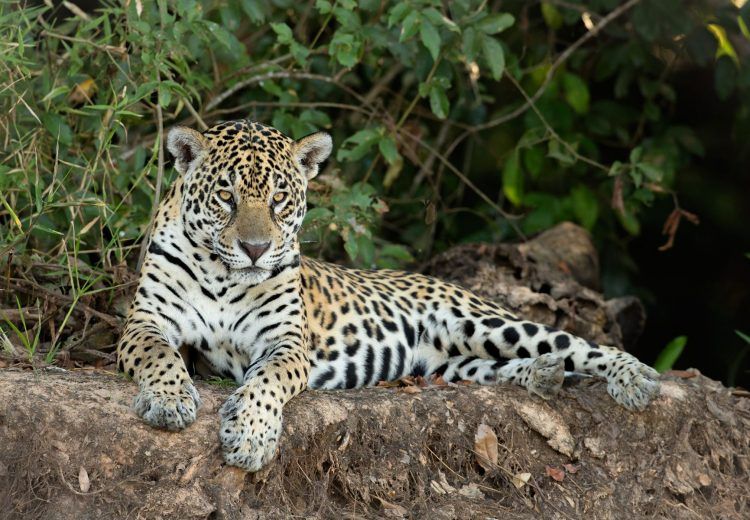
South America (including Galapagos)
August 2025
BRAZIL’S PANTANAL: JAGUARS AND SO MUCH MORE – South America’s best wildlife photography destination
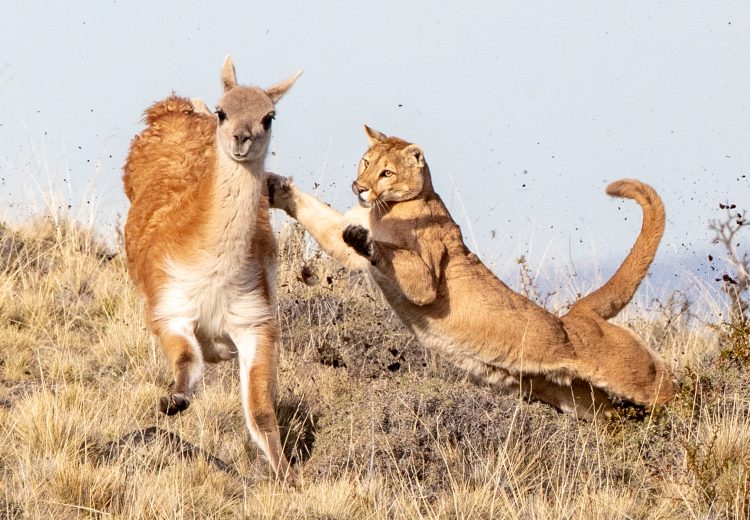
South America (including Galapagos)
September 2025
CHILE: WALKING WITH PUMAS – An Extraordinary Photographic Adventure at Torres del Paine
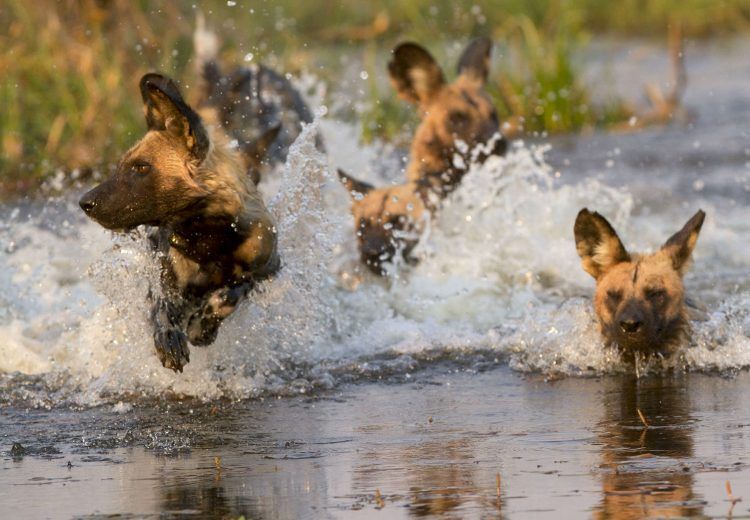
Botswana & The Okavango
November 2025

